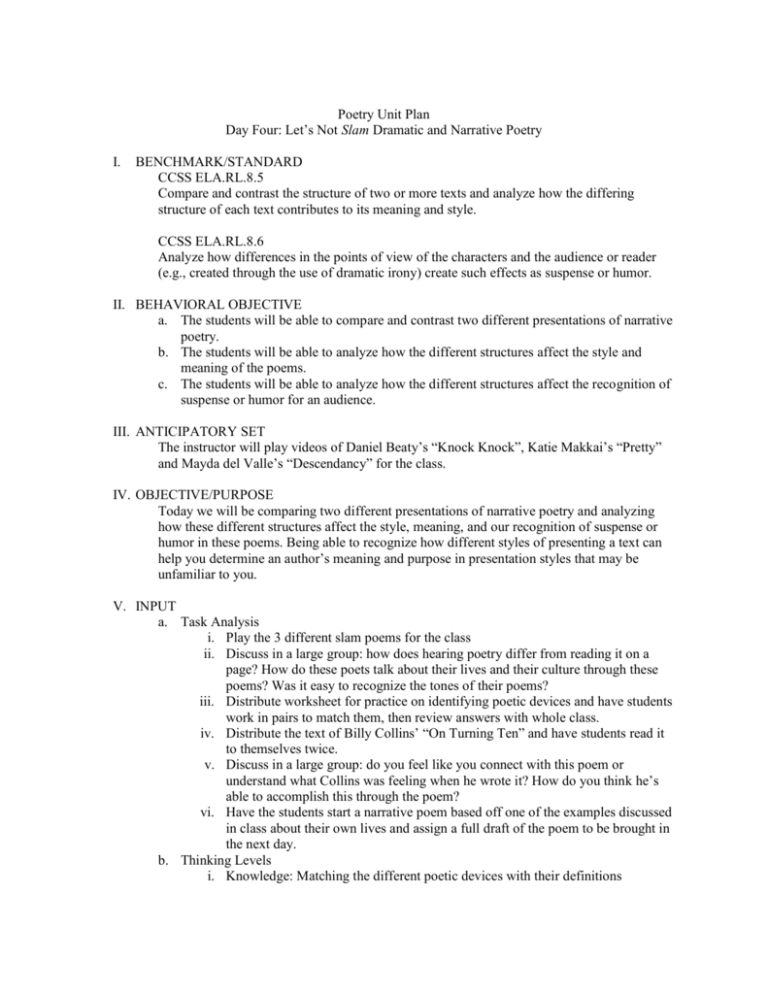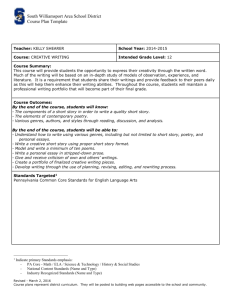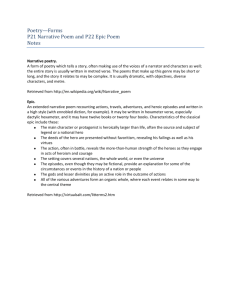File - Ashleigh N. Bowne
advertisement

Poetry Unit Plan Day Four: Let’s Not Slam Dramatic and Narrative Poetry I. BENCHMARK/STANDARD CCSS ELA.RL.8.5 Compare and contrast the structure of two or more texts and analyze how the differing structure of each text contributes to its meaning and style. CCSS ELA.RL.8.6 Analyze how differences in the points of view of the characters and the audience or reader (e.g., created through the use of dramatic irony) create such effects as suspense or humor. II. BEHAVIORAL OBJECTIVE a. The students will be able to compare and contrast two different presentations of narrative poetry. b. The students will be able to analyze how the different structures affect the style and meaning of the poems. c. The students will be able to analyze how the different structures affect the recognition of suspense or humor for an audience. III. ANTICIPATORY SET The instructor will play videos of Daniel Beaty’s “Knock Knock”, Katie Makkai’s “Pretty” and Mayda del Valle’s “Descendancy” for the class. IV. OBJECTIVE/PURPOSE Today we will be comparing two different presentations of narrative poetry and analyzing how these different structures affect the style, meaning, and our recognition of suspense or humor in these poems. Being able to recognize how different styles of presenting a text can help you determine an author’s meaning and purpose in presentation styles that may be unfamiliar to you. V. INPUT a. Task Analysis i. Play the 3 different slam poems for the class ii. Discuss in a large group: how does hearing poetry differ from reading it on a page? How do these poets talk about their lives and their culture through these poems? Was it easy to recognize the tones of their poems? iii. Distribute worksheet for practice on identifying poetic devices and have students work in pairs to match them, then review answers with whole class. iv. Distribute the text of Billy Collins’ “On Turning Ten” and have students read it to themselves twice. v. Discuss in a large group: do you feel like you connect with this poem or understand what Collins was feeling when he wrote it? How do you think he’s able to accomplish this through the poem? vi. Have the students start a narrative poem based off one of the examples discussed in class about their own lives and assign a full draft of the poem to be brought in the next day. b. Thinking Levels i. Knowledge: Matching the different poetic devices with their definitions ii. Application: Employing the new knowledge of narrative poetry structures to large group discussion iii. Analysis: Analyzing the two different narrative poetry structures and comparing and contrasting the way they affect a reader’s/listener’s view of the poem iv. Synthesis: Creating their own narrative poem based off of the class discussions on structure c. Learning Styles i. Visual: Learners will see the words of the poems in front of them as well as watch the slam poets presenting their poetry, and the poetry terms on the worksheet ii. Auditory: Learners will hear the slam poets speaking the words of their poems aloud. iii. Intrapersonal: Learners will spend time alone working on their own poems iv. Interpersonal: Learners will work in pairs and have large group discussion on narrative poetry and poetic devices v. Aural: Learners will read the texts of a poem d. Method and Materials i. Ways of presenting: lecture, discussion, pair and large group work, silent reading, audio/video clips ii. Materials needed: youtube.com, Billy Collins’ “On Turning Ten”, poetic devices matching worksheet VI. MODELING a. VII. CHECKING FOR UNDERSTANDING a. VIII. GUIDED PRACTICE a. IX. INDEPENDENT PRACTICE a. X. CLOSURE a. Knowledge: b. Comprehension: c. Assessment:






